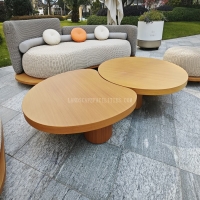Welcome to the website for landscape facilities products and knowledge.
How does the table accommodate different seating arrangements or chair types?
Contemporary table designs have evolved remarkably to accommodate diverse seating requirements and chair styles. The secret lies in several innovative features that transform ordinary tables into versatile centerpieces for any space.
Extendable mechanisms represent one of the most practical solutions for flexible seating. These tables incorporate clever sliding systems or butterfly leaves that can expand the surface area by up to 50%, effortlessly accommodating additional guests during gatherings while maintaining a compact footprint for daily use. The precision engineering ensures smooth operation while supporting substantial weight distribution.
Modular table designs take adaptability to another level entirely. Featuring interconnecting sections that can be rearranged in multiple configurations—from traditional rectangles to creative T-shapes or even separate smaller tables—these systems empower users to customize their layout based on the occasion. This approach proves particularly valuable for commercial spaces requiring frequent reconfiguration.
Adjustable height mechanisms address the fundamental challenge of pairing different chair types. Whether using sleek bar stools, standard dining chairs, or low-profile lounge seating, hydraulic or crank-operated systems enable perfect alignment between table surface and chair height. This ergonomic consideration ensures comfort while maintaining visual harmony despite varying furniture proportions.
Table base configurations significantly impact seating flexibility. Pedestal bases eliminate obstructive legs, allowing chairs to tuck completely underneath without spatial constraints. Conversely, strategically placed hairpin legs or slim-profile bases create clear pathways for wheelchair accessibility while accommodating bulkier chair designs that might otherwise collide with traditional table supports.
The integration of durable, adaptable materials further enhances this versatility. Scratch-resistant surfaces withstand frequent rearrangement, while rounded corners facilitate smoother traffic flow in tight spaces. Some manufacturers even incorporate reversible tops or interchangeable leg systems, enabling complete style transformations to match evolving interior schemes.
Ultimately, modern table design transcends mere aesthetics to embrace true functional adaptability. Through intelligent engineering and thoughtful features, today's tables seamlessly bridge the gap between fixed architecture and flexible living requirements, proving that furniture can indeed be both beautiful and brilliantly practical.
Related search:

Recommendation
Elliptical metal outdoor table with nested design, resembling wood grain, round table